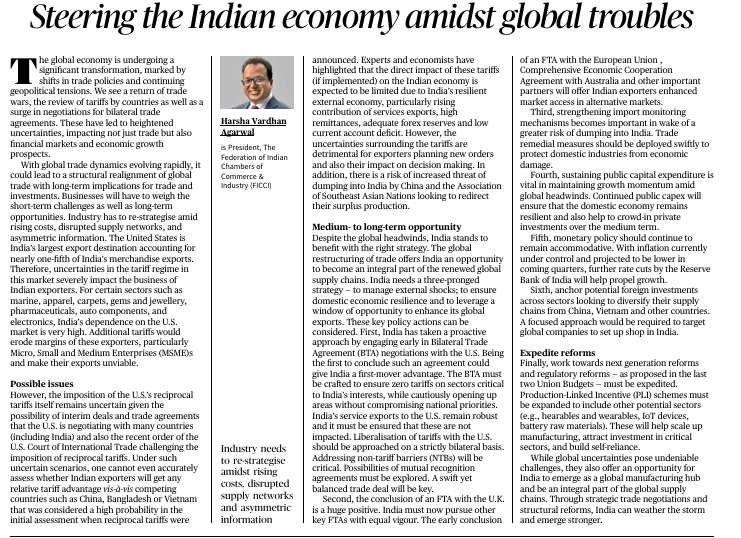1. Context: Global Economic Transformation
- The global economy is witnessing:
- Shifts in trade policies.
- Rising geopolitical tensions.
- Reevaluation of trade agreements and tariffs.
- Shifts in trade policies.
- These trends impact global trade, capital flows, and financial markets.
2. India’s Export Vulnerability
- USA is India’s largest export destination (~20% of exports).
- Sectors like marine, apparels, carpets, gems & jewellery, pharma, auto components are at high risk.
- Increased US tariffs and slowdown can hurt Indian MSMEs and export earnings.
3. Short-Term Challenges
- Rising logistics costs.
- Disrupted supply chains.
- Asymmetric information about trade measures.
- Dumping threats from countries like China and ASEAN nations redirecting exports to India.
4. Need for Strategic Response
- India must restructure supply chains and improve resilience.
- Requires a three-pronged strategy:
- Domestic shock absorption (policy buffers, inflation control).
- Leveraging external opportunities (new trade agreements).
- Policy support for industry competitiveness (ease of doing business, subsidies, PLI schemes).
- Domestic shock absorption (policy buffers, inflation control).
5. Trade Agreements as Leverage
- India is negotiating:
- Bilateral Trade and Economic Partnership Agreement (BTEPA) with the US.
- FTAs with EU, UK, Australia.
- Bilateral Trade and Economic Partnership Agreement (BTEPA) with the US.
- These deals are important to:
- Secure market access.
- Avoid non-tariff barriers.
- Promote domestic industry participation in global value chains.
- Secure market access.
6. Steps Suggested in the Editorial
- Strengthen early warning systems: To counter dumping and import surges.
- Sustain public capital expenditure: Helps cushion domestic economy in downturns.
- Continue monetary easing: Inflation is moderating, creating room for lower interest rates.
- Support diversification of markets: Expand exports to Vietnam, China, other Asian countries.
- Focus on productivity-linked incentive (PLI) schemes: Target next-gen sectors like electronics, green hydrogen, batteries, and semiconductors.
7. Long-Term Vision
- India can benefit from global trade restructuring by:
- Becoming a reliable part of global supply chains.
- Improving logistics, reducing regulatory hurdles.
- Creating a stable trade and investment policy environment.
- Becoming a reliable part of global supply chains.
UPSC-Style Questions (GS3 – Indian Economy)
🔹 10-Marker (150 Words)
How do global trade policy shifts affect India’s export-dependent sectors? Discuss with recent examples.


